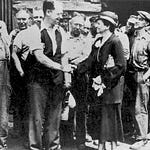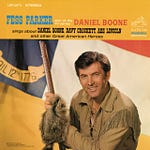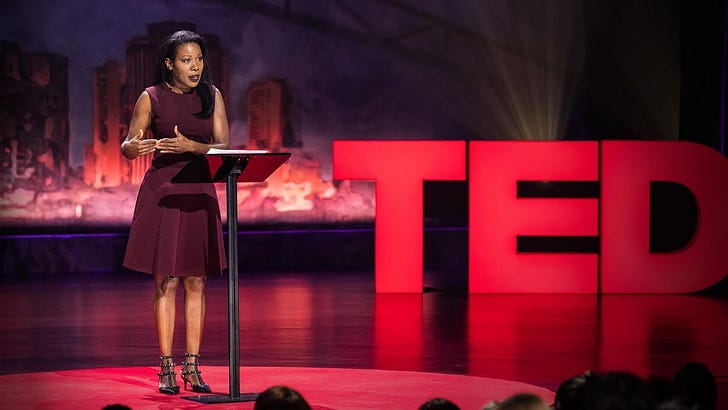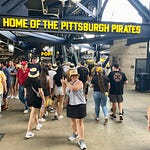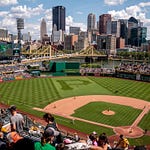I’m sending this from somewhere between North Carolina and Phoenix, Arizona during my trip to visit family. I had to delay my motorcycle trip by five days waiting for the turbulent storms to dissipate in the lower Midwest and upper South, which has led to extremely high waters along our beloved Ohio River. The Associated Press has revived historical memories of the Great Flood of 1937, which killed 385 people and left approximately one million homeless from Pittsburgh to Cairo, Illinois.
I wrote my last newsletter about the Covington flood wall murals, which have been doing strong work this spring, and I’m continuing the theme today with flood wall mural trivia.
Note to my fantastic new subscribers:
Monthly trivia is for sport. It’s not a test of intelligence or character. I couldn’t answer these questions without a significant amount of research, either! Do your best and enjoy learning something new. Oh, and if you do, would you share the quiz with someone else?
QUESTIONS
Answers in the footnotes.
Who painted the Covington flood wall murals?1
a) Diego Rivera started them before his death. His large frescoes helped establish the mural movement.
b) Robert Dafford painted them all. He’s an internationally acclaimed mural artist and blues enthusiast from Louisiana who has painted more than 400 murals in the United States and Europe.
c) Thomas Hart Benton, a Missouri native who was at the forefront of the Regionalist art movement. His fluid, sculpted figures showed everyday people in scenes of life in the United States.
d) Shepard Fairey, an American contemporary artist, activist and founder of OBEY Clothing who emerged from the skateboarding scene.What is the primary purpose of the murals? Only one applies.2
a) To advertise local businesses
b) To beautify the city with abstract art
c) To depict and preserve the region’s layered history
d) To showcase modern Kentucky lifeWhat river(s) does the Covington flood wall protect against? More than one may apply.3
a) Kentucky River
b) Licking River
c) Ohio River
d) Sciota RiverThe mural that features the Roebling Suspension Bridge highlights a major architectural achievement linking Covington and Cincinnati. What role did this bridge play in regional commerce, and why was its construction significant for Covington’s identity? More than one answer may apply.4
It facilitated the transport of goods between Covington and Cincinnati, strengthening the region’s role as a key industrial hub.
Until the invention of the Model T, it was primarily a pedestrian bridge that connected two cultural districts in the region, boosting tourism and art exchange.
Its engineering innovation—as the first major suspension bridge in the U.S. to use wire cables—made it an architectural marvel of its time while helping solidify Covington's identity by connecting it to the economic and cultural heart of Cincinnati.
It was the first bridge to connect Covington to the rest of the United States, fostering a boom in agricultural exports.
The mural known as Resident Artists, features Frank Duveneck and John Farney. Which of the following is true of these artists? Choose wisely.5
The inclusion of John Farney and Frank Duveneck suggests that Covington’s cultural history was primarily shaped by international art movements rather than local artists.
The inclusion of Frank Duveneck and John Farney highlights Covington’s strong cultural and artistic legacy, which extended beyond its industrial growth in the late 19th century.
A mural depicting the Latonia Race Track shows a lively day at what was once one of the most prestigious Thoroughbred tracks in the country. Which of the following is true about the mural and what it represents, historically? Choose one.6
In the mural, the jockey in red silks wears a badge with the initials “A.J.” This is widely understood to be a tribute to Alonzo “Lonnie” Clayton, one of the most successful Black jockeys in American horse racing history.
The mural shows the grand reopening of the racetrack in the 1950s, after World War II prompted a decades-long closure.
The jockeys in the mural are all modeled after famous Triple Crown winners, despite none ever racing at Latonia.
The mural known as Covington Churches features several of Covington’s historically and architecturally significant churches, depicting the city’s religious diversity. True or false: One of the houses of worship in that mural is a Jewish temple.7
Also depicted in that mural is the Western Baptist Theological Institute, founded in Covington in the 1840s. The seminary owned a large amount of land in the region. What happened to this land after the seminary dissolved over disagreements about whether ministers could enslave people?8
a) The land was sold to local businesses for commercial development.
b) It was repurposed as a public park and remains a popular site for community events.
c) The land became part of Northern Kentucky University's original campus and other civic developments.
d) The land was used to create a historic landmark to honor the seminary’s contributions to education.The mural known as 1913: Federal Ball Park captures the energy of a baseball game in the early 20th-century with players, fans, and the iconic stadium in the background. True or false: Federal Ball Park was the home of the Cincinnati Reds before they moved to Crosley Field in 1912.9
Which of the following best describes the challenges and benefits of integrating more murals into Covington’s urban landscape, considering recent initiatives the development of immersive public art?10
Mural expansion would likely face little resistance, with most community members favoring its aesthetic value and historical preservation benefits.
Integrating more murals would enhance Covington’s cultural identity, but it could be challenged by concerns over historical accuracy, economic costs, and the preservation of existing architecture.
Covington is committed to expanding its mural project as part of an effort to revitalize the city and attract tourists.
The city of Covington is focused on creating new murals specifically to erase older, controversial historical representations.
INTERMISSION
Mark your calendars if you live between Portsmouth, Ohio and Louisville, Kentucky. For the fifth year, paddlers will complete the Ohio River Way Challenge, an extraordinary expedition in 30-foot voyager canoes from May 5-15. Details here!
I can’t make it this year, but it’s on my calendar for 2026!
ANSWERS
The correct answer is b) Robert Dafford, who has painted loads of public murals, many of them on flood walls.
The correct answer is c) To depict and preserve the region’s layered history. That being said, they are indeed sponsored by a combination of corporations, local businesses, and individuals as alluded to in answer a). This collaborative funding approach ensures the murals' creation and ongoing maintenance.
The only correct answer is c) the Ohio. But if you think about it, the Licking, Kentucky, and Sciota Rivers are tributaries to the Ohio, so all four answers are correct in principle. Score yourself as your conscience permits.
Since this question was twofold, the answers are a) and c). In short, while the bridge did contribute to the city’s skyline, its true significance lay in its practical function and its role in shaping the region's growth and identity.
While Farney had French connections and Duveneck studied extensively in Germany, the two artists were important figures in American art. While Farney was indeed influenced by French styles, his work and influence were deeply rooted in the American art scene, particularly in Kentucky and the broader region. Covington was shaped by its artists' contributions to the American art landscape, including their roles in regional and national art movements, not just as an offshoot of European styles. Therefore, the correct answer is b).
The only correct answer is a). Clayton won the Kentucky Derby in 1892 at the age of 15, making him the youngest jockey ever to do so—a record that still stands. During the late 1800s, Black jockeys dominated the sport, particularly in Kentucky, where many were formerly enslaved or descendants of enslaved people who had developed expert horsemanship working with thoroughbreds.
The mural doesn't call attention to this with a spotlight or plaque—true to the subtle style of the Covington flood wall series—but the “A.J.” badge is a quiet, respectful nod to a legacy that has often been erased or overlooked in mainstream accounts of horse racing history.
b) is false because the original Latonia Race Track closed permanently in 1939 and was not reopened.
c) is also false. While Latonia was prestigious, it was not part of the Triple Crown circuit, and the mural honors local and historical significance rather than national champions.
True. By 1911, there were approximately 35 Jewish families residing in Covington. Most of the people were of Polish or Russian descent. That year, Rabbi Samuel Levinson of United Hebrew Congregation in neighboring Newport, began offering religious services in the Kentucky Post building on Madison Avenue.
Covington’s fledgling Jewish community began plans to build a synagogue in the city in 1912 with the purchase of a lot at 7th and Greenup Streets. The Great Depression was hard on the congregation and Temple Israel was condemned in 1937. The Federal Government decided to build a new Federal Building and Post Office on that site. By the mid-1960s, Temple Israel in Covington ceased to function as an active congregation.
The only correct answer is c). Founded in 1833, the Western Baptist Theological Institute was established to train ministers for the western states. The location in Covington, Kentucky, offered proximity to Cincinnati (across the river), but the property on the Kentucky side was less expensive than the land in Cincinnati. In this way, the committee felt that the institution would have the support of the Kentucky and other southern Baptists. In 1835, the committee purchased nearly 350 acres of ground.
On May 8, 1845, Baptist delegates from the southern states met in Augusta, Georgia and formally established the Southern Baptist Convention, a move that was both theological and political. The theological aspect was more about how slavery was interpreted in light of Christian doctrine, but it was fundamentally a political issue involving the rights of the South to maintain slavery as an institution. This split would have grave consequences for the Western Baptist Theological Institute. Donations plummeted along with the student enrollment.
In 1855, the board decided to close the Western Baptist Theological Institute. Both factions agreed to a sale of all the property, with the proceeds being divided equally.
In August 1855, the Main building of the institute was sold to W. Scott. Mr. Scott operated a small female college and preparatory school in the building for several years. During the Civil War, the hospital was utilized as a convalescent hospital for wounded Union soldiers.
In 1867, the building was purchased by the Sisters of the Poor of St. Francis. The sisters relocated their St. Elizabeth Hospital to the site. St. Elizabeth Hospital occupied the building until 1914 when the current hospital was completed. In 1916, the main building of the Western Baptist Theological Institute was razed and Wadsworth Electric Company was built on the site. The land eventually became part of Northern Kentucky University's original campus and other civic developments.
True
The only correct answer is b) Integrating more murals would enhance Covington’s cultural identity, but it could be challenged by concerns over historical accuracy, economic costs, and the preservation of existing architecture.






